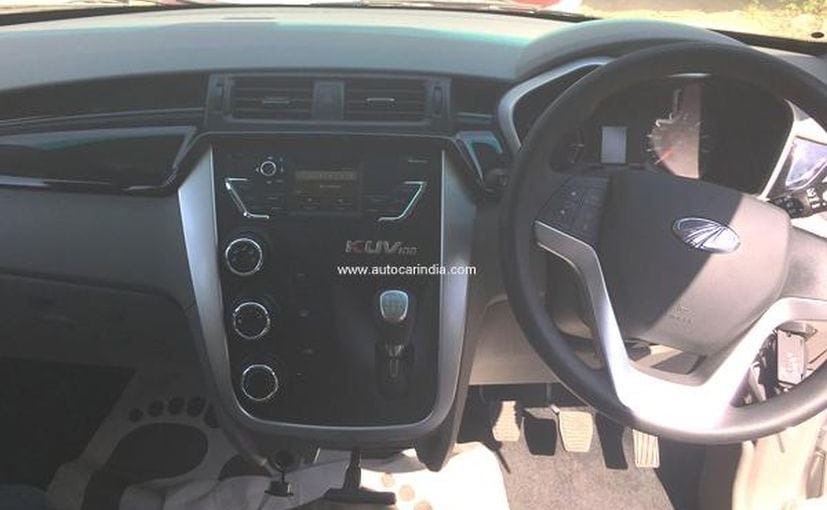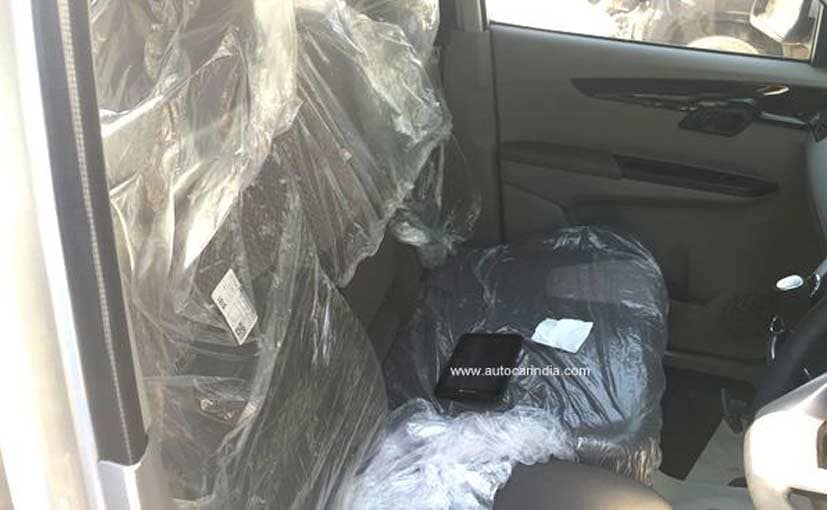Mahindra KUV100
launch in India is scheduled for January 15, 2016 and with the car's
arrival in the country barely 10 days away, the buzz around the mini SUV
only seems to grow by the minute. In preparation of its upcoming
launch, some reports claim that the Mahindra KUV100 has already started
arriving at dealerships across the country. One must also know that the
sub-compact SUV, which was previously known as the Mahindra S101, will
have Varun Dhawan as its brand ambassador. While unveiling the Mahindra
KUV100 last month, the carmaker had said that over 1000 units of the car
have already been manufactured.
While Mahindra revealed the exterior images of the car in December, not much was known about the interiors. However, the Mahindra KUV100's cabin was recently spied that gives much insight about what will be on offer.
 The spy pictures suggest that the car photographed is the top-end
variant in the 6-seat layout. The spied Mahindra KUV100 sports a bench
seat in the front, the gear lever has been placed on the dashboard,
while the pull-type handbrake is right below the centre console.
Furthermore, the KUV100 mini SUV sports rectangular AC vents atop the
centre console with the heating, ventilation and air conditioning (HVAC)
controls positioned vertically (on the left of the gear lever).
The spy pictures suggest that the car photographed is the top-end
variant in the 6-seat layout. The spied Mahindra KUV100 sports a bench
seat in the front, the gear lever has been placed on the dashboard,
while the pull-type handbrake is right below the centre console.
Furthermore, the KUV100 mini SUV sports rectangular AC vents atop the
centre console with the heating, ventilation and air conditioning (HVAC)
controls positioned vertically (on the left of the gear lever).
 Mahindra KUV100, where KUV stands for 'Kool Utility Vehicle', will
come powered by an all-new engine line-up that will also power future
models from the carmaker's stables. The 1.2-litre mFalcon G80 petrol
unit, the first petrol engine to be created from scratch by Mahindra, is
the lightest engine in its segment, is made up of an all-aluminium
body, and develops 82bhp of power along with 114Nm of peak torque. The
turbocharged common-rail diesel engine, mFalcon D75, develops 77bhp and
190Nm of torque. Both the engines will be mated to a 5-speed manual
gearbox.
Mahindra KUV100, where KUV stands for 'Kool Utility Vehicle', will
come powered by an all-new engine line-up that will also power future
models from the carmaker's stables. The 1.2-litre mFalcon G80 petrol
unit, the first petrol engine to be created from scratch by Mahindra, is
the lightest engine in its segment, is made up of an all-aluminium
body, and develops 82bhp of power along with 114Nm of peak torque. The
turbocharged common-rail diesel engine, mFalcon D75, develops 77bhp and
190Nm of torque. Both the engines will be mated to a 5-speed manual
gearbox.
Expected to come with a starting price of 4.5 lakh, the Mahindra KUV100 sub-compact SUV currently has no competition in the Indian automobile market. With that being said, it does find a rival in the Hyundai Grand i10 if only the price were to be a consideration. As far as other upcoming cars go, the Mahindra car can expect to face competition from the upcoming Maruti Suzuki Ignis.
(Source: Autocar India)
While Mahindra revealed the exterior images of the car in December, not much was known about the interiors. However, the Mahindra KUV100's cabin was recently spied that gives much insight about what will be on offer.


Expected to come with a starting price of 4.5 lakh, the Mahindra KUV100 sub-compact SUV currently has no competition in the Indian automobile market. With that being said, it does find a rival in the Hyundai Grand i10 if only the price were to be a consideration. As far as other upcoming cars go, the Mahindra car can expect to face competition from the upcoming Maruti Suzuki Ignis.